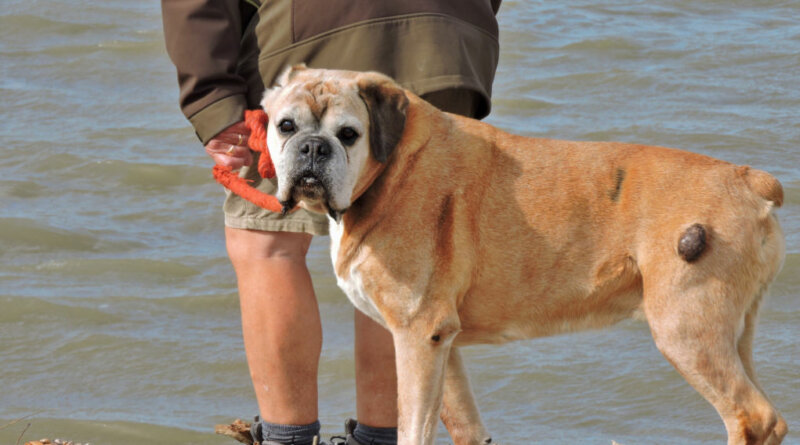Top 7 Most Common Cancers in Dogs
[ad_1]
Cancer affects many different animals, not just humans. Sadly, sometimes our furry friends can develop different types of cancer.
Some are hereditary, but most cancers we know little about.
It is good to be informed about the most common cancers in dogs and their symptoms and treatments since you can immediately seek help for your pup’s condition.
Listed below are the seven most common cancers in dogs, and information pet owners should know about each.
Signs of Cancer In Dogs
Cancer is a deadly disease because some of the symptoms can be the same as less fatal problems.
However, if your dog shows unusual signs where they seem different than yesterday then you should pay close attention.
If it starts to go on for more than a day, whether fatal or not, call a vet and bring them in for a check-up.
Here are some symptoms of cancer in dogs you’ll want to pay attention to:
- A wound that doesn’t seem to be getting better
- Bleeding or discharge from somewhere
- They have lost their appetite
- They have rapidly lost weight without any change in diet
- Your dog has an unusual smell that’s different than normal
- Your dog has swelling of certain joints or lymph nodes
- Panting or difficulty breathing
- They appear sluggish and suddenly lethargic
- Difficulty eating or swallowing food
- Walking with a gimp, looks like they are in pain, lameness or stiff
- Not interested in exercising when they were just the other day
- Lumps and bumps on and underneath the skin
Most Common Cancers in Dogs
Melanoma
Melanoma is nothing to joke about and is one of the most common cancers in dogs.
7% of all active tumors in dogs are melanoma.
This type of cancer usually affects the dog’s mouth since it is oral cancer.
Thankfully, most skin tumors are benign and don’t affect your puppy.
However, if you notice any changes in their skin or coat, you should take them to a vet for a biopsy.
Common symptoms of Melanoma include a round red or brown mass growing on a dog’s face, including the mouth, nose, eye, and ear.
The mass is about ¼ inch to 2 inches and grows.
When it is caught early, vets can usually remove the tumor before spreading and monitor any changes in your dog.
Not all masses are cancerous, but if they ooze with pus or smell foul, they could be cancerous or infected.
Chemotherapy is an option, but it is expensive and does not have a high success rate.
Lung Cancer
Your dog does not have to inhale a lot of gas or smoke to develop lung cancer.
Scientists are still unsure how this type of cancer develops in humans or dogs, but there are risks.
It is common in older dogs past seven years old and rapidly infects and spreads throughout the body.
This is the most challenging form of cancer in dogs because of how aggressive it is.
When it is just one tumor, it can easily be removed and treated. Still, chemotherapy is the only course of action when it spreads.
The only way to diagnose lung cancer in a dog is to do an X-ray or CT scan.
The symptoms of early-stage lung cancer are coughing, shortness of breath, and fever. Rapid weight loss is common once it spreads.

Osteosarcoma
Dogs can develop different bone cancers, but osteosarcoma is the most common.
Interestingly, large dog breeds have a higher risk of developing this type of bone cancer between the ages of 4 through 7.
The tumors spread quickly, especially if they are not removed immediately.
It is difficult to diagnose or predict if your dog has bone cancer.
This aggressive bone cancer attacks dogs by leaving them with fatigue, a loss of appetite, a decrease in muscles, and frail bones.
It is essential to schedule regular vet checks if your dog has a genetic link to this fast-spreading cancer.
The most giant red flag that your dog may have osteosarcoma is if they suddenly injure itself frequently.
Broken bones and inflammation are joint as bone cancer weakens the bones.

Mast Cell Tumors
Mast Cell Tumors are one of the most common cancers in dogs. It actually makes up 20% of all skin cancers treated in pets. This type of cancer attacks the connective tissues close to a dog’s skin, including the lungs, nose, and skin.
Mast cell tumors can be deadly.
Fortunately, there are also many different types of treatments your vet may recommend, like surgery, radiation therapy, chemotherapy, and pain medications.
The life expectancy of a dog with this cancer depends on the grade and aggressiveness of the tumor.
For example, they may only live 4-6 months with treatment if it is high-grade.
The good thing about Mast cell tumors is they are physically visible.
You can spot one of your dogs easily since they are large masses that develop right underneath the skin.
You should report any new growth immediately to a professional.

Lymphoma
Some cancers in dogs are not visible, like lymphoma.
This type of cancer sometimes causes swelling and redness around your dog’s lymph nodes.
However, this also happens when your dog fights an infection.
In that scenario, swelling and redness are common and not usually something to be concerned about.
Lymphoma is cancer affecting lymphocytes (blood cells) and lymphoid tissues.
Treatment, symptoms, and the expected life expectancy of lymphoma depend on your dog’s type.
There are four main types of lymphoma:
- multicentric lymphoma
- alimentary lymphoma
- extranodal lymphoma
- mediastinal lymphoma

Hemangiosarcoma
Sadly, hemangiosarcoma is the deadliest cancer that affects dogs.
Hemangiosarcoma is cancer of the blood vessel walls that can produce tumors anywhere in the body.
However, the heart and spleen are the most common areas affected by hemangiosarcoma tumors.
What’s worse is that this cancer develops and spreads fast.
And while any dog can develop it, it is most common in Golden Retrievers, German Shepherds, and Labrador Retrievers.
Most of the time, the symptoms mask the problem, and diagnosing doesn’t occur until it is too late and cancer has spread quickly.
Removing the tumor is possible, but because it is in the blood vessels, it is a hazardous procedure that is not 100% successful.
Some symptoms of hemangiosarcoma are lethargy, increased heart rate, and weak mussels.

Mammary Cancer
Mammary cancer affects female and male dogs but is most common in female dogs.
Mammary cancer is confusing, and there are few studies on how it develops in dogs.
Still, some researchers believe it is because of a lack of spaying.
When female dogs are not spayed within the first two years of life, they have a higher chance of developing mammary cancer.
A significant risk that can increase your dog’s chances is early obesity.
This type of cancer has good odds, and most dogs live long lives after treatment, which usually requires surgery to remove the tumor to keep it from spreading.
Dachshunds are more likely than other dogs to develop mammary cancer, but we aren’t entirely sure why.
What To Do if Your Dog Has Cancer?
No one ever expects to hear that their beloved fur baby has cancer.
As hard as it is, though, most diagnoses require fast thinking and important decisions. Know that you are not alone during these situations.
First, feel your emotions. It is a challenging situation that no one wants to go through.
I had a Labrador-basset hound mixed dog named Sparky, who had a rare type of bone cancer at 13 years old, and it was hard.
Thankfully, the fantastic vet and her office team were there every step of the way.
Find out your treatment options and their pricing.
Most offices and local cities have funding and charity for treatments. It is good to take it to step by step.
FAQs On The Most Common Dog Cancers
What is the fastest growing cancer in dogs?
The fastest growing cancer found in dogs are mast cell tumors.
These tumors show up as hard bumps under the dog’s skin. Mast cell tumors are skin cancer and are deadly if left untreated and they reach the lymphnodes.
Another fast growing cancer is Hemangiosarcoma. It spreads to almost any part of the body and quickly. A vet check up will most likely find the cancer in a dog’s heart and spleen.
Related
[ad_2]
Source link






Hi, i feel that i noticed you visited my site so i came to go back
the prefer?.I am attempting to to find issues to enhance
my web site!I assume its adequate to make use of a few of your ideas!!
Вывод из запоя представляет собой важный этап в процессе лечения алкогольной зависимости. Это медицинская процедура, необходимая для устранения токсических веществ, накопленных в организме в результате длительного употребления алкоголя. Алкогольная зависимость может вызывать множество проблем, включая физические и психоэмоциональные расстройства. Своевременное вмешательство специалистов помогает минимизировать риски и способствует восстановлению здоровья пациента.
Выяснить больше – [url=https://vyvod-iz-zapoya-13.ru/vivod-iz-zapoya-anonimno-v-ryazani/]vyvod iz zapoya anonimno nedorogo ryazan[/url]
What’s up mates, pleasant paragraph and good arguments commented at this place, I am actually enjoying by these.
Incredible points. Sound arguments. Keep up the amazing effort.
Fantastic blog! Do you have any helpful hints for aspiring writers?
I’m planning to start my own blog soon but I’m a little lost on everything.
Would you propose starting with a free platform like WordPress or go for a paid option? There are so many options
out there that I’m completely overwhelmed .. Any suggestions?
Thanks a lot!
Awesome! Its in fact amazing paragraph, I have got much
clear idea on the topic of from this piece of writing.
Hey very nice website!! Man .. Beautiful .. Wonderful ..
I’ll bookmark your web site and take the feeds additionally?
I’m glad to seek out a lot of helpful info here in the post, we want develop extra strategies in this regard, thanks for sharing.
. . . . .